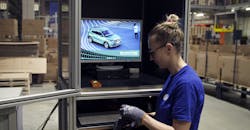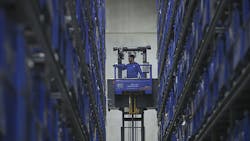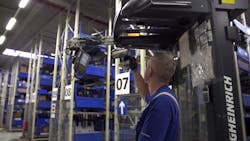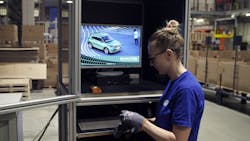Often the phrase “factory floor” stirs up an outdated image of a man in overalls, plugging away at a conveyor belt, turning raw materials into widgets. Or, popular culture provides dystopic visions of a workerless factory, one where the machines rule and churn out widgets at a frenetic pace.
I work with some of the biggest manufacturers in the world—from Bosch to BMW, and many in between—and what I see is different. I see a world where machines are increasingly designed to work closely with their human counterparts and augment the skills of a factory worker. The technological advancements we are revolutionizing the factory floor to make the worker safer and more effective.
In fact, recent statistics from the U.S. Labor Department have confirmed my suspicions. Manufacturing has grown by 327,000 new jobs over the last year, which represents the best 12-month stretch in 23 years. And the MAPI Foundation predicts that investment in the U.S. manufacturing sector will continue to grow over the next several years.
An employee scans the desired box from a distance, which allows a single worker to scan multiple boxes, integrated with a central database. The central database, connected through Bluetooth, creates efficiency gains and better tracking.
Technology Empowering Workers, Keeping Them Safe
Today, connected devices are providing near-instant data to IT and information systems so workers can accomplish more. This decentralized approach provides a new opportunity for workers, who can be more autonomous from middle management.
For example, glasses provide instructions through augmented reality. Such glasses can help take the guesswork out of complex processes or train new employees rapidly. Perhaps most importantly, they identify unsafe practices before they turn into habits and lead to injuries…or worse. Other examples include vests that alert forklifts when a worker is close, or scanning technology and smart gloves that scan items from a distance—saving time and reducing repetitive strain injuries.
Such items allow for workers to focus on their jobs. Distractions are one of the main causes of injury, and concentrating on the tasks in front of them, rather than the many items vying for their attention, allows workers greater efficiency and makes the industrial workplace safer.
A worker uses a ProGlove scanner while looking at the data on a nearby tablet. Industries adapting wearable technologies include logistics, manufacturing, and retail.
The Worker at the Heart of the Future Factory
As I see it, the worker is a crucial part of the ongoing evolution of the industrial ecosystem. As with previous waves of automation and technology change, the worker will become more productive, safer, and produce higher-quality results. Mass adoption of fully automated factories in the foreseeable future will remain an illusion due to a number of factors: too many product varieties, short life-cycles, and the general need for creativity and adaptability on the factory floor.
Workers will evolve through their tools, similar to how it has happened over the past several millennia. Advances in technology will lead to better working conditions and greater gains for the company.
An employee puts a charged scanner on the glove. Each scanner can run for nearly two shifts, 15 hours, on a single charge. Such battery lives are greatly increasing the usability of wearables across a number of industries.
Most exciting, though, is that these technologies are really just in their beginnings. We have decades more to see the symbiosis between man and machine play out. Or, as we think of it at ProGlove, how the human fits with a machine, technology that fits like a glove.
Charlie Grieco recently joined ProGlove as vice president of sales and North American operations. Grieco will oversee the smart wearable maker’s North American sales activities and report directly to CEO Andreas König. Grieco has more than 20 years of experience and held management positions at AetherPal, SOTI, Dell, and other renowned organizations.
About the Author
Charlie Grieco
Vice President of Sales and North American Operations
Charlie Grieco recently joined ProGlove as vice president of sales and North American operations. Grieco will oversee the smart wearable maker’s North American sales activities and report directly to CEO Andreas König. Grieco has more than 20 years of experience and held management positions at AetherPal, SOTI, Dell, and other renowned organizations.




